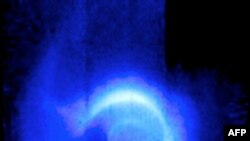NASA scientists say a small but significant “dent” in Earth’s magnetic field is expanding and splitting and continuing to weaken intensity, which could impact low-orbit satellites circling the globe.
According to scientists, Earth’s magnetic field acts like a protective shield, blocking and trapping charged particles — or radiation — from the sun that could otherwise cause harm but are more likely to affect electronic equipment, like satellites.
But the “dent,” or weak spot, in the magnetic field over South America, known to scientists as the South Atlantic Anomaly (SAA), allows radiation to penetrate Earth’s surface. The scientists have observed no ill effects to daily life on the planet. But they have observed the anomaly is moving westward and appears to be splitting.
Scientists say Earth is a bit like a bar magnet with north and south poles that represent opposing magnetic polarities and invisible magnetic field lines encircling the planet between them.
Earth’s magnetic field is generated from its outer core, 1,800 miles below the surface, comprised of molten iron and other metals that are constantly churning and acting like a giant generator – known as geodynamo — that generates electric currents that produce the magnetic field. Because of the constant motion, the magnetic field is not perfectly aligned throughout the globe, nor is it perfectly stable.
Scientists say these fluctuations, along with the tilt of Earth’s magnetic axis, are what causes the SAA. Because of the radiation it allows, the region can be hazardous to satellites that pass through it. They can short-circuit a satellite’s onboard computer or cause other glitches.
Scientists will monitor the changes in the SAA because it tells them about changes in the Earth's core and how its dynamics influence other aspects of Earth’s systems.
